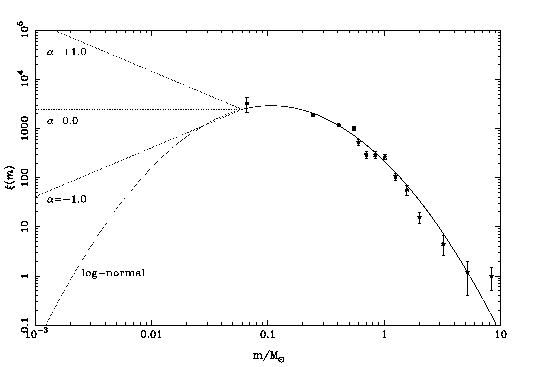Our knowledge of the stellar mass function
Since the pioneering work of Salpeter(1955), there have been many
determinations of the MF for various stellar clusters and associations
reaching ever lower masses. In restricted mass ranges, MFs have
usually been modelled using power law forms,  . For example, Salpeter (1955) found
alpha=2.35 in the solar neighbourhood. However, later work
demonstrated a flattening of the MF at low masses m<0.3M(sun). A
better fit to the observed MF over a large mass range is the
log-normal function (e.g. Miller & Scalo 1979; Hambly et al. 1999b):
. For example, Salpeter (1955) found
alpha=2.35 in the solar neighbourhood. However, later work
demonstrated a flattening of the MF at low masses m<0.3M(sun). A
better fit to the observed MF over a large mass range is the
log-normal function (e.g. Miller & Scalo 1979; Hambly et al. 1999b):

i.e.  is normally distributed
about characteristic mass mC with width sigma.
is normally distributed
about characteristic mass mC with width sigma.
The deepest data available show a flat, slowly rising or slowly
decreasing MF in the substellar regime (e.g. Lucas & Roche 2000;
Martin, Zapatero-Osorio & Rebolo 1998), and it is now clearly
important to firmly establish the form of the MF in as many clusters
as possible, with good statistics, to build upon these new
results. The possibility that free-floating planetary mass objects
exist (Lucas & Roche 2000; Zapatero-Osorio et al. 2000), and if so,
their relation to the ''exoplanets'' being found in increasing numbers
are related questions that can be tackled given sufficiently deep
survey data (see the exoplanets.org web page for further information on
extrasolar planets).
Theoretical predictions of the form of the IMF have advanced
considerably over the last decade or so. Simple scaling arguments
predict power-law forms of the IMF in a hierarchical fragmentation
procedure (Zinecker, McCaughrean & Wilking 1993). However, some more
recent work (Adams & Fatuzzo 1996) has concentrated on the following
compelling argument: in the limit that many independent physical
variables come into play in the SF process, then the central limit
theorem dictates that the IMF should approach a log-normal
distribution. This clearly has important implications for normal
distributions having characteristic masses m~0.1M(sun) (e.g. Hambly et
al. 1999b; Adams & Fatuzzo 1996) since the number of BDs predicted at
m~0.01M(sun) becomes very low (see later) relative to power-law forms
with all except the most negative exponents. There is currently not
enough observational data to verify (or refute) such interesting
theories.

Figure 4.1. Various extrapolations (dotted lines)
of the Pleiades mass function (after Hambly et al. 1999) illustrating
the present uncertainties in the behaviour of the MF in the brown
dwarf regime.
Our current knowledge of the mass function is summarised in Figure
4.1, which shows the Pleiades mass function and various feasible
extrapolations. It is clear that its is crucial to measure the mass
function in the sub-stellar regime. The most extreme objects (a few
Jupiter masses) are in principle the most sensitive test, but we may
simply not find any. The practical next step is to find and count
brown dwarfs in the 20-100 Jupiter mass regime.
 . For example, Salpeter (1955) found
alpha=2.35 in the solar neighbourhood. However, later work
demonstrated a flattening of the MF at low masses m<0.3M(sun). A
better fit to the observed MF over a large mass range is the
log-normal function (e.g. Miller & Scalo 1979; Hambly et al. 1999b):
. For example, Salpeter (1955) found
alpha=2.35 in the solar neighbourhood. However, later work
demonstrated a flattening of the MF at low masses m<0.3M(sun). A
better fit to the observed MF over a large mass range is the
log-normal function (e.g. Miller & Scalo 1979; Hambly et al. 1999b):

 is normally distributed
about characteristic mass mC with width sigma.
is normally distributed
about characteristic mass mC with width sigma.
